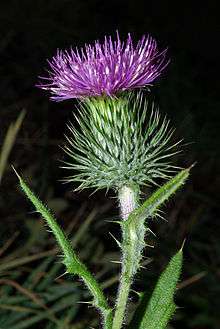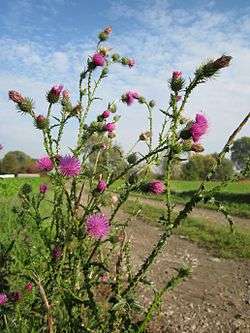Carduus acanthoides
| Carduus acanthoides | |
|---|---|
 | |
| Carduus acanthoides flower head | |
| Scientific classification | |
| Kingdom: | Plantae |
| (unranked): | Angiosperms |
| (unranked): | Eudicots |
| (unranked): | Asterids |
| Order: | Asterales |
| Family: | Asteraceae |
| Tribe: | Cynareae |
| Genus: | Carduus |
| Species: | C. acanthoides |
| Binomial name | |
| Carduus acanthoides L. | |
Carduus acanthoides, known as the spiny plumeless thistle, welted thistle, and plumeless thistle, is a biennial plant species of thistle in the Asteraceae—sunflower family. The plant is native to Europe and Asia.
Distribution
The plant is native from France, Italy, and western Turkey; through Russia and Kazakhstan; to China.[1] In its native range the plant is found in open grasslands and disturbed areas, and in non-native ranges it is a weed of annual grasslands, roadsides, fields and pastures, and disturbed areas. The plant has distributed as an invasive species across North America.[2]
Description

Carduus acanthoides may exceed 2 metres (6.6 ft) in height and can form weedy monotypic stands. The stem and foliage are spiny and sometimes woolly. The plant starts from a flat basal rosette and then bolts an erect stem with occasional toothed, wrinkled, spiny leaves.[3]
At the top of each branch of the stem is an inflorescence of one to several flower heads, each rounded, covered in spiny phyllaries, and bearing many threadlike purple disc florets. The achenes are 2-3 mm long, with faint lengthwise stripes. Pappus bristles are 11-13 mm long.
Invasive species
Carduus acanthoides is well known in many other parts of the world, including parts of North and South America, New Zealand, and Australia, as a noxious weed. It is an invasive species in many regions of Canada and the United States, including California and West Virginia.[4] [5] The California Department of Food and Agriculture has an active program to control known populations.[6] Carduus acanthoides presents multiple factors in growth and reproduction that negatively influence native species.[7] This invasive species has spread easily across different regions due to the fact that it spreads through its seeds, and each plant itself creates around 1,000 seeds alone.[8]
References
- ↑ Species account from ARS Germplasm Resources Information Network (GRIN) — Carduus acanthoides . accessed 4.8.2013
- ↑ "Plants Profile for Carduus acanthoides (spiny plumeless thistle)". plants.usda.gov. Retrieved 2016-11-07.
- ↑ "Cal-IPC: Carduus acanthoides". www.cal-ipc.org. Retrieved 2016-09-16.
- ↑ USDA . accessed 4.8.2013
- ↑ Jepson
- ↑ Cal-IPC (California Invasive Plants Council) — Carduus acanthoides (plumeless thistle) . accessed 4.8.2013
- ↑ "Exotic Species: Spiny Plumeless Thistle (U.S. National Park Service)". www.nps.gov. Retrieved 2016-09-14.
- ↑ Rauschert, Emily S. J.; Shea, Katriona; Goslee, Sarah (2015-01-01). "Plant community associations of two invasive thistles". AoB Plants. 7: plv065. ISSN 2041-2851. PMC 4571105
 . PMID 26038126. doi:10.1093/aobpla/plv065.
. PMID 26038126. doi:10.1093/aobpla/plv065.
External links
| Wikimedia Commons has media related to Carduus acanthoides. |
- USDA Plants Profile for Carduus acanthoides (spiny plumeless thistle)
- Jepson Manual Treatment of Carduus acanthoides
- Carduus acanthoides — U.C. Photo gallery